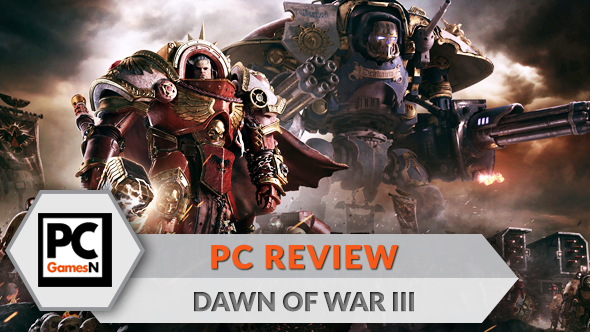
Forget your Facebook feed, Warhammer 40Ok’s depiction of the long run is kind of presumably the worst imagined in any in style fiction. It’s populated by factions so used to perpetual battle that they’ve built-in warfare into the very material of their societies, religions and cultures.
Read extra: the best RTS games (and other strategy titles) on PC.
All this makes 40Ok the right setting for an RTS sport, as we’ve already found on two earlier events with the Dawn of War collection. The newest entry, Dawn of War III, is a extra self-aware tackle the mythos, whereas additionally enjoying like a extra conventional RTS at coronary heart. It doesn’t do a lot new, however Relic Entertainment have made positive that these acquainted issues it does do are delivered with booming confidence and nice character.
In the marketing campaign you rotate between management of three warring factions – the zealous Space Marines, the snobbish house elves of the Eldar, and the Orks… who’re each bit thuggish charmers you need them to be. Each aspect is vying to get their palms on a strong pointy stick referred to as the Spear of Khaine, whereas an Eldar prophecy tells of a rogue planet that’s set to crash with the human planet of Cyprus Ultima. The Space Marine and Eldar plots are fronted by old-timer Gabriel Angelos and Farseer Macha respectively, each of whom are having to cope with megalomaniacal, self-serving commanders in addition to their rivals. The Ork protagonist, in the meantime, is returning Warboss Gorgutz, who’s amassing a military by overpowering fellow Ork warchiefs and declaring himself their chief, or Megaboss, as I think about they’d say in Orkish parlance.
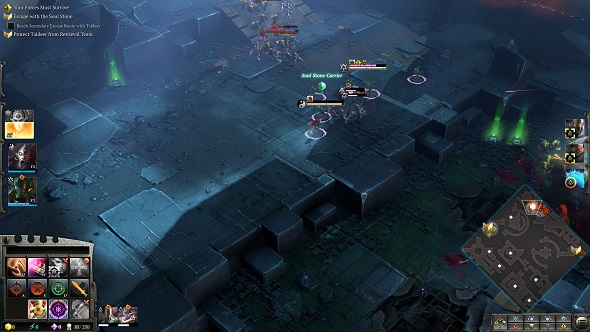
The plot is properly offered utilizing nonetheless photos and conversations between missions, with the sombre horns and house whirs of the background music establishing a weighty melancholy tone. Each aspect is given sufficient motive that whoever you align with, you care concerning the final result. The a number of views are becoming for a universe of infinite warfare, the place issues are not often as simple as a matter of Good vs Evil (in a manner, everybody’s a murderous savage, the Orks are simply extra sincere about it). The erudite conceitedness of the Eldar and earnestness of the Space Marines distinction properly with the freewheeling Ork horde, who gained me over by means of the sheer drive of persona that runs by means of each side of their presentation – from the structure of their buildings, to their soundbites and magnificence of play.
Each faction performs distinctly. The Space Marines supply your customary RTS development and techniques, with steady bases, improve constructions, and an array of traditional mixed arms models. The Eldar’s biggest benefit comes with their motion pace and teleporting bases and models. You can zap all of their key constructions just about anyplace on the map when you’ve acquired the upgrades, making them nice for shock assaults and maintaining your enemy guessing as to your subsequent transfer. Relocating bases on a regular basis and maintaining observe of what teleports went the place bought a bit fiddly for my creaking mouse-hand, however the strategic benefits of the Eldar for extra pro-level RTS gamers than myself are clear.
Then there are the Orks. Man, how I like these guys. They’re such a rowdy, personable bunch that I wish to hang around with them, consuming grog, partaking in pissing contests and rocking out beneath the blaring audio system of their WAAAAGH towers. Even simply hovering round Ork bases and watching their rickety, shaking buildings clanging away, churning models from their shoddy maw-like entrances is a pleasure to behold. Along with upgrading their military by means of buildings, Orks can acquire scrap across the battlefield to improve and construct automobiles. Best of all, you possibly can pump them up for battle by standing them round WAAAAGH towers, and making them hearken to 15 or so seconds of Ork Metal music, giving them short-term pace and assault boosts; watching them roar then rush into battle after one in all these mosh pits climaxes is a second of RTS sublimeness. But even the little particulars are nice. From the cowardice of the employee Gretchins once you get them organized to construct a construction, to the broken-voice mania of the Shooter Boyz, the Orks are presumably essentially the most heartily enjoyable faction I’ve ever managed in an RTS (honourable point out to the Orcs of Warcraft II).
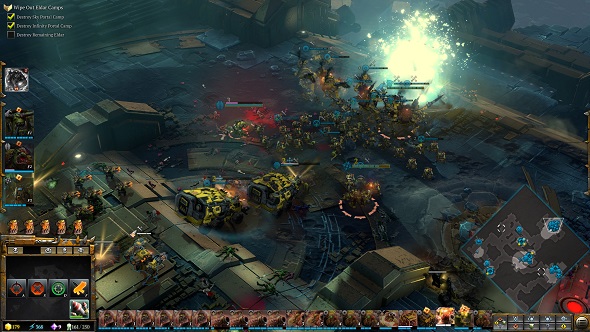
Casting apart my private obsession with the Orks, Dawn of War III achieves the essential process of creating every faction viable and satisfying. There’s some good self-aware swagger to the Space Marines too, as chilly ‘motivational’ bulletins often blare out on tannoys, providing posthumous honours for Marines doing their responsibility, and thanking them for his or her perseverance in the event that they’re experiencing issues with their go well with air provides. It’s a tongue-in-cheek manner of claiming that each soldier – in Warhammer as within the RTS style – is expendable and replaceable, and acknowledges that the collection is at a stage the place it could make just a little enjoyable of itself.
Being of the normal flavour, Dawn of War III doesn’t introduce any mechanics that can persuade non-RTS followers that the style has developed and have to be revisited. For returning Dawn of War gamers, essentially the most notable distinction would be the reintroduction of base-building after a hiatus final time spherical. The system kills off any hope for these searching for a ‘Dawn of Company of War Heroes’, if you’ll, changing it unapologetically with unit-spawning and defensive constructions which you can plonk down anyplace on the map. There’s micro-management aplenty, as you break up your models into management teams, ship out scouts to search out the enemy, and have interaction in sizeable skirmishes the place you need to present prudence in realizing which models to focus on, when to modify your models’ assaults between melee and ranged, and when to retreat. It’s all very competent, however take away the superb presentation and also you’re left with a somewhat old-school RTS that doesn’t really feel as formidable because the devs’ earlier work.
Each mission feels substantial, often divvied up into three mini-acts which are a mixture of small-scale quests involving hero models, timed set-pieces, doubtful stealth sequences and, in fact, beefy base-building adopted by epic confrontations and base-smashing. While providing a well-balanced and sometimes suspenseful mixture of actions, the tempo generally falters. There have been too many events when sources have been so scarce that I needed to wait 5 or extra minutes to rebuild my military, with no menace from the enemy and nothing a lot to do however watch these overly acquainted useful resource and energy counters tick as much as a degree the place I may convert them into models. You’d have thought that after 20 or so years of the style’s existence on this type, a stalwart developer like Relic may’ve give you an answer to this sort of thumb-twiddling nothingness.
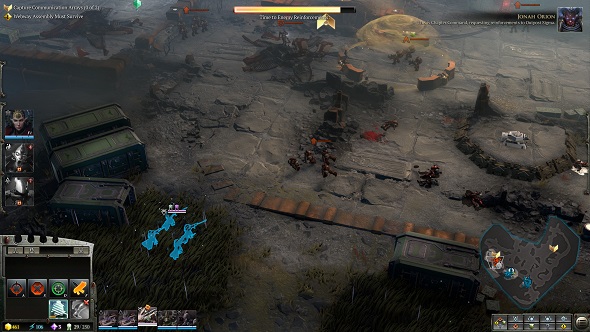
Every faction’s models brim with distinctive skills that stability out their varied benefits and downsides. Eldar infantry, for instance, are typically extra fragile than their rivals, however cost into battle utilizing the Howling Banshees’ Quick Strike, and with them you shortly degree the enjoying subject. They additionally possess loads of elusive aerial models in addition to a genetic propensity for working pace and teleporting. Space Marines have the benefit of concussive skills comparable to Whirlwind artillery strikes, jetpacking Storm Troopers, and Dreadnought Slams, whereas Orks, conscious upcyclers that they’re, have an enormous array of automobiles they’ll create out of battlefield detritus.
When all this this equipment of warfare collides, the resultant carnage is every little thing you’d wish to see from a Warhammer 40Ok RTS. When armies collide, they achieve this with impression, as troops sporting seemingly impenetrable armour get disembodied by vicious claws, chainswords and searing laser beams. Battlefields develop into pockmarked as you bombard them, and strewn with ruined buildings, non-biodegradable corpses and giblets of fallen warriors as you combat for management of them. Seeing a map degenerate from a creaking area of warfare right into a blood-and-metal tub may be very satisfying.
A giant swinger in these skirmishes will probably be Elite models, that are unlocked as you acquire battle expertise and may be summoned at any level (once more, they’re expendable as you possibly can revive them after a set period of time). These vary from clubbing melee tanks just like the hammer-swinging Gabriel Angelos and be-clawed Gorgutz, to ethereal caster sorts just like the Eldar’s Ronahn and Farseer Macha, proper as much as spectacular behemoth super-units like Imperial Knight Solaria and the Eldar Wraithknight.
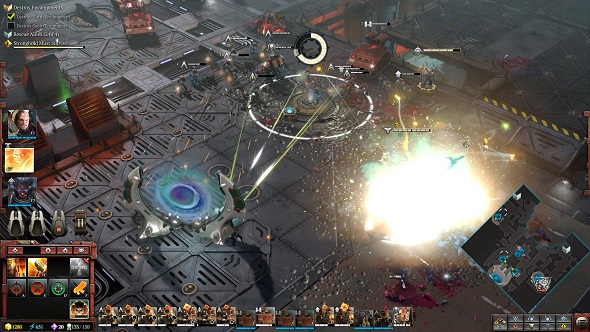
As properly as providing apparent tactical benefits, these models carry the gravitas of Warhammer 40Ok historical past. There’s likelihood you’ll recognise the hulking Space Marine Terminators, for instance, whereas the skullheaded Chaplain Diomedes (nice title) and likeable Orks with monikers like Weirdboy Zapnoggin and Beauty da Morkanaut bespeak the universe’s wealthy lore and character design. It’s all a formidable showcase of the 40Ok universe’s heritage, and it’s telling which you can admire these elite models within the menus, rotating them round on spherical platforms very like you’ll your previous bodily Warhammer 40Ok fashions (unpainted, in my case). In quick, the 40Ok universe is superior, Relic comprehend it, they usually make rattling positive you already know it too.
While there aren’t any noteworthy modes or improvements to talk of in Dawn of War III’s multiplayer element (no Halo Wars 2-style Blitz, for instance), the arena-like maps assist make sure the battles are balanced and brisk. There’s a pleasant crossover too between single and multiplayer, as you possibly can degree as much as get doctrines – passive and lively boosts to your armies and elite models – which you can switch between the 2. With that mentioned, simply the one sport mode (for now) and an absence of the single-player marketing campaign’s narrative drive doesn’t compel me to maintain at it, though extra hardcore gamers and purists will little doubt take pleasure in its no-nonsense, esport-friendly method.
Seeing as Relic redefined the RTS with their WWII-based video games, it’s a bit baffling that not one of the nuances or complexities are to be seen right here, particularly after Dawn of War II appeared to take a couple of small steps in that path. Defensive constructions, infantry digging in, and snipers holing up within the infinite ruins peppering the degrees would’ve fitted brilliantly with the 40Ok mythos, particularly as these items are such an integral a part of the tabletop sport. Instead, the environments function little greater than backdrops (that includes the occasional pre-determined defensive construction) somewhat than precise battlefields providing notable tactical potentialities. It appears a tad wasteful from a developer identified for his or her savvy use of environments and defensive methods in RTS video games.
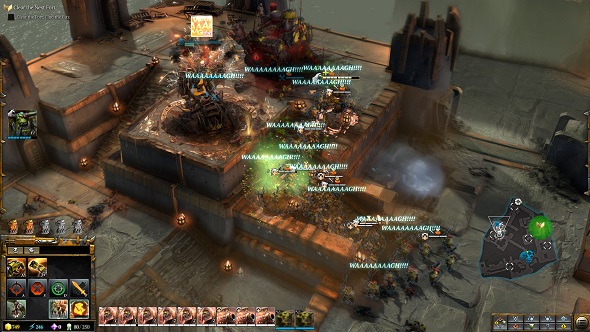
But whereas Relic clearly had no intention of fomenting one other RTS revolution right here, they at the very least labored throughout the present order to create a vivid futuristic hellhole of superior spectacle and scale. Gurning, screaming Orks slamming right into a squadron of austere Space Marines, slick large Darkwraiths colliding with clanging Orkine machinations, and large-scale cosmic carnage sum up the ethos right here; DoW III is a sport of huge, meaty encounters and twitch-quick micro-management somewhat than sneaky ambushes and environmental techniques, and it delivers on that with the shredding impression of a chainsword slicing by means of an Ork’s cranium.
Within that, Dawn of War III nails the narrative and distinctive mechanics for every faction, making a agency, steely basis for extra factions to be thrown in at a later date. It thrills me to consider how Relic would combine the Chaos Marines, Tyranids, or my beloved Imperial Guard into this format, and see them given the identical excessive degree of consideration as the present contestants.
This is essentially the most standard RTS in an traditionally unconventional collection. While this reality alone could divide gamers, its high quality of presentation and polished mechanics imply that, because it inevitably expands with extra content material, Dawn of War III could but develop into the champion of a style that continues to be stubbornly proof against evolution.
Verdict: eight/10
Source


